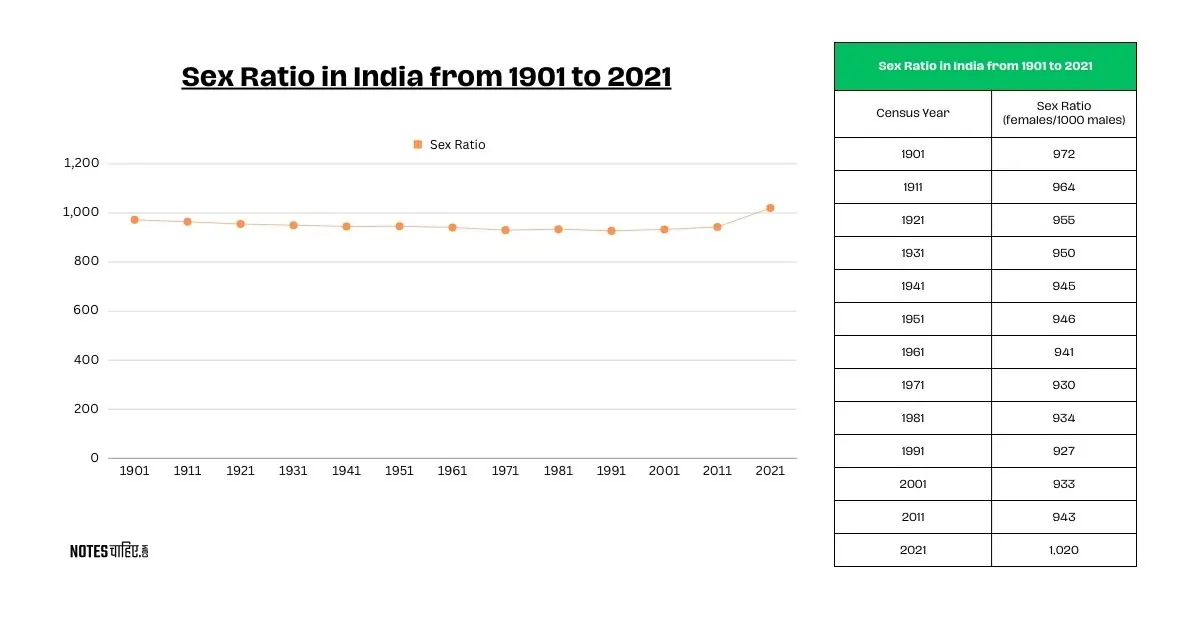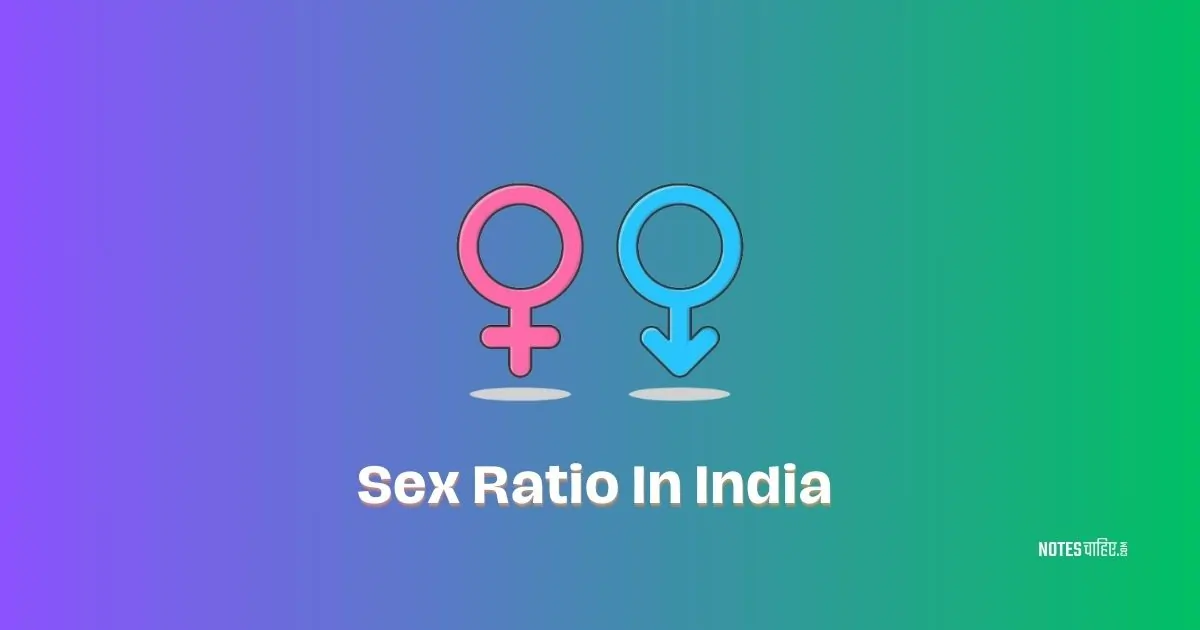Sex Ratio in India 2024: The distribution of men and women in a population is a crucial indicator of societal dynamics. The sex ratio, reflecting the number of girls per 1,000 boys, offers insights into gender equity and impacts various aspects such as mortality rates, migration patterns, marriage trends, and economic dynamics.
A ratio of 1,000 signifies gender balance, while deviations indicate imbalances, with more than 1,000 indicating a surplus of girls and less than 1,000 signaling a deficit.
Understanding the sex ratio is pivotal for examining the fairness and functioning of society. And here we have provided the analysis for Sex Ration In India 2024.
Sex Ratio In India 2024: Definition, Types and Factors
Sex Ratio, also known as Gender Ratio, denotes the proportion of males to females in a population. This ratio is critical for understanding demographic dynamics.
Fisher’s principle suggests a 1:1 ratio for most sexually reproducing species, but real-world ratios can deviate significantly.
This article explores the concept of sex ratio, with a particular emphasis on its situation in India, offering essential insights for candidates preparing for the IAS Exam.
The sex ratio in India, measured as females per 1000 males, witnessed changes from the 2011 Census to the 2024 NFHS-5 Survey.
In rural areas, there has been a notable increase from 949 in 2011 to 1037 in 2024.
Similarly, urban areas experienced a shift from 929 in 2011 to 985 in 2024. At the national level, the sex ratio rose from 943 in 2011 to 1020 in 2024, reflecting evolving demographic patterns.
| Sex Ratio in India 2024 | ||
| Sex Ratio (Females per 1000 Males) | 2011 Census | 2024 (NFHS-5 Survey) |
| Rural | 949 | 1037 |
| Urban | 929 | 985 |
| India | 943 | 1020 |
Useful Insights about Sex Ration Of India 2024
| Highest Sex Ratio in India | |
|---|---|
| Kerala | 1084 |
| Tamil Nadu | 995 |
| Andhra Pradesh | 992 |
| Lowest Sex Ratio in India | |
|---|---|
| Haryana | 877 |
| Jammu and Kashmir | 883 |
| Sikkim | 889 |
| Child Sex Ratio (0-6 years) – Top Performers | |
|---|---|
| Mizoram | 971 |
| Meghalaya | 970 |
| Chhattisgarh | 964 |
| Child Sex Ratio (0-6 years) – Lowest Performers | |
|---|---|
| Haryana | 830 |
| Punjab | 846 |
| Jammu and Kashmir | 859 |
| Union Territories (UTs) – Top Overall Sex Ratio | |
|---|---|
| Puducherry | 1038 |
| Lakshadweep | 946 |
| Andaman and Nicobar Islands | 878 |
| Union Territories (UTs) – Lowest Overall Sex Ratio | |
|---|---|
| Daman and Diu | 618 |
| Dadra and Nagar Haveli | 775 |
| Chandigarh | 818 |
| States and UTs with Declining Overall Sex Ratios | |
|---|---|
| Bihar | |
| Jammu and Kashmir | |
| Dadra and Nagar Haveli | |
| Daman and Diu | |
| Lakshadweep |
| Improving Child Sex Ratios (0-6 years) in Census 2011 | |
|---|---|
| Punjab | 798 to 846, +57 points |
| Haryana | 819 to 830, +11 points |
| Himachal Pradesh | 896 to 906, +10 points |
| Chandigarh | 845 to 867, +22 points |
| Gujarat | 883 to 886, +3 points |
| Tamil Nadu | 942 to 946, +4 points |
| Mizoram | 964 to 971, +7 points |
| Andaman & Nicobar Islands | 957 to 966, +9 points |
| Telangana Demographics (formed in 2014) | |
|---|---|
| Total Population | 351.94 lakhs |
| Male Population | 177.04 lakhs |
| Female Population | 174.90 lakhs |
| Sex Ratio (Female per 1000 Males) | 988 |
| Child Sex Ratio | 933 |
Types of Sex Ratio
Sex ratio is categorized into four subdivisions based on the age of the population:
- Primary sex ratio — ratio at fertilization
- Secondary sex ratio — ratio at birth
- Tertiary sex ratio — ratio in sexually mature organisms
- Quaternary sex ratio — ratio in post-reproductive organisms
These categories, while somewhat subjective, provide a nuanced understanding of sex ratio variations across different life stages.
| Types | Other Name | Definition | Example or Context |
|---|---|---|---|
| Primary Sex Ratio | Ratio at conception | Reveals the initial distribution of males and females during early development, considering abortion, miscarriage, and live birth data. | Examining the primary sex ratio helps us understand gender dynamics from the very beginning of life, offering insights into initial conceptions. |
| Secondary Sex Ratio | Ratio at birth | The balance between male and female births, providing insights into natural gender distribution among newborns. | An example of the secondary sex ratio is 105:100, indicating 105 male births for every 100 female births, offering a snapshot of gender at birth. |
| Tertiary Sex Ratio | Ratio among sexually mature individuals aged 20 and above | Indicates the proportion of males to females in this age group. | In a population with a tertiary sex ratio of 110:100, there are 110 sexually mature males for every 100 females aged 20 and above. This sheds light on gender dynamics in the adult population. |
Factors for the Declining Sex Ratio in India:
Several factors contribute to the declining sex ratio in India, including:
- Sex selection abortion
- Neglect at birth or childhood
- Cultural preference for male children
- Failures in implementing the Prenatal Conception and Prenatal Determination Act (PC-PNDT) of 1994
The PC-PNDT aims to prevent healthcare officials from revealing the gender of the child, but its effectiveness is hampered by poor implementation and exploitation of loopholes.
Societal Prejudices and Economic Factors:
Prejudices towards the female child, driven by cultural beliefs and economic considerations such as dowry, contribute to a societal preference for male children.
This preference can lead to financial burdens on families with daughters and, in extreme cases, resentment against female offspring.
The surplus of males in society can result in societal instability, violence, and antisocial behavior.
Steps to Address the Declining Gender Ratio:
To counter the declining sex ratio, the government has implemented initiatives like Beti Bachao Beti Padhao since 2015.
Additionally, the Ministry of Women and Child Development and the Ministry of Education have proposed measures such as:
- Making education affordable and accessible
- Conducting gender sensitization campaigns
- Ensuring women’s safety on public transport
- Reaching out to young people to reduce population momentum
Insights from the Historical Trend of Sex Ratio in India:

- Long-Term Decline:
- The sex ratio in India has consistently decreased since 1901, indicating a historical preference for boys over girls.
- Magnitude of Decline:
- From 972 females per 1,000 males in 1901, the sex ratio dropped significantly to 940 in 2011, highlighting a substantial gender imbalance at birth.
- Post-Independence Trends:
- After independence, the decline persisted for about two decades, reaching its lowest point in 1971 with a sex ratio of 930 females per 1,000 males.
- Minor Improvements:
- While there have been minor changes since then, the issue of fewer girls being born still demands attention. The 2021 sex ratio shows improvement at 1,020 females per 1,000 males.
- Concerns for Gender Equality:
- The data underscores historical preferences for male children, posing challenges to gender equality. Continuous efforts are needed to address societal and cultural factors contributing to this preference.
- Government Initiatives:
- Ongoing efforts, possibly through government initiatives and awareness campaigns, are crucial to addressing root causes leading to imbalanced sex ratios.
- Importance of Continued Action:
- The historical trend signals a deep-rooted problem requiring sustained action and policy interventions. Continued efforts are crucial for fostering a balanced and equitable sex ratio in India, ensuring a fair and inclusive society for future
Sex Ratio in India from 1901 to 2021
| Sex Ratio in India from 1901 to 2021 | ||
| S.N. | Census Year | Sex Ratio (females/1000 males) |
| 1. | 1901 | 972 |
| 2. | 1911 | 964 |
| 3. | 1921 | 955 |
| 4. | 1931 | 950 |
| 5. | 1941 | 945 |
| 6. | 1951 | 946 |
| 7. | 1961 | 941 |
| 8. | 1971 | 930 |
| 9. | 1981 | 934 |
| 10. | 1991 | 927 |
| 11. | 2001 | 933 |
| 12. | 2011 | 943 |
| 13. | 2021 | 1,020 |
States and UTs Rank Wise Sex Ratio In India
Below is showing the Rank Wise Sex Ration Of States and UTs as per census 2021.
| Sex Ratio of States and UTs Data | ||
| State/UT Rank | Name of state or Union Territory | Sex Ratio of India 2021 |
| 1. | Kerala | 1084 |
| 2. | Puducherry | 1038 |
| 3. | Tamil Nadu | 995 |
| 4. | Andhra Pradesh | 992 |
| 5. | Chhattisgarh | 991 |
| 6. | Manipur | 987 |
| 7. | Meghalaya | 986 |
| 8. | Odisha | 978 |
| 9. | Mizoram | 975 |
| 10. | Himachal Pradesh | 974 |
| 11. | Karnataka | 968 |
| 12. | Goa | 968 |
| 13. | Uttrakhand | 963 |
| 14. | Tripura | 961 |
| 15. | Assam | 954 |
| 16. | Jharkhand | 947 |
| 17. | West Bengal | 947 |
| 18. | Lakshadweep | 946 |
| 19. | Nagaland | 931 |
| 20. | Madhya Pradesh | 930 |
| 21. | Rajasthan | 926 |
| 22. | Maharashtra | 925 |
| 23. | Arunachal Pradesh | 920 |
| 24. | Gujarat | 918 |
| 25. | Bihar | 916 |
| 26. | Uttar Pradesh | 908 |
| 27. | Punjab | 893 |
| 28. | Sikkim | 889 |
| 29. | Jammu& Kashmir | 883 |
| 30. | Andaman & Nicobar islands | 878 |
| 31. | Haryana | 877 |
| 32. | NCT of Delhi | 866 |
| 33. | Chandigarh | 818 |
| 34. | Dadra and Nagar Haveli | 775 |
| 35. | Daman and Diu | 618 |
| Overall | India | 943 |
The Highest Sex Ratio In the Indian States
| Highest Sex Ratio in the Indian States | ||
| Rank. | States | Sex Ratio |
| 1 | Kerala | 1121 |
| 2 | Rajasthan | 1099 |
| 3 | Bihar | 1090 |
| 4 | Tamil Nadu | 1088 |
| 5 | Manipur | 1066 |
| 6 | Odisha | 1063 |
| 7 | Jharkhand | 1050 |
| 8 | Telangana | 1049 |
| 9 | West Bengal | 1049 |
| 10 | Andra | 1045 |
Lowest Sex Ratio in the Indian States
| Lowest Sex Ratio in the Indian States | ||
| SNo | States | Sex Ratio |
| 1 | Haryana | 926 |
| 2 | Punjab | 938 |
| 3 | Gujrat | 965 |
| 4 | Maharashtra | 966 |
| 5 | Madhya Pradesh | 970 |
| 6 | Sikkim | 990 |
| 7 | Arunachal Pradesh | 997 |

